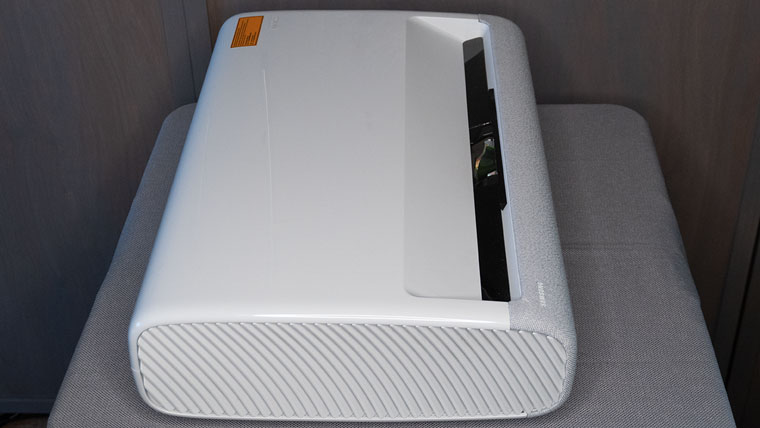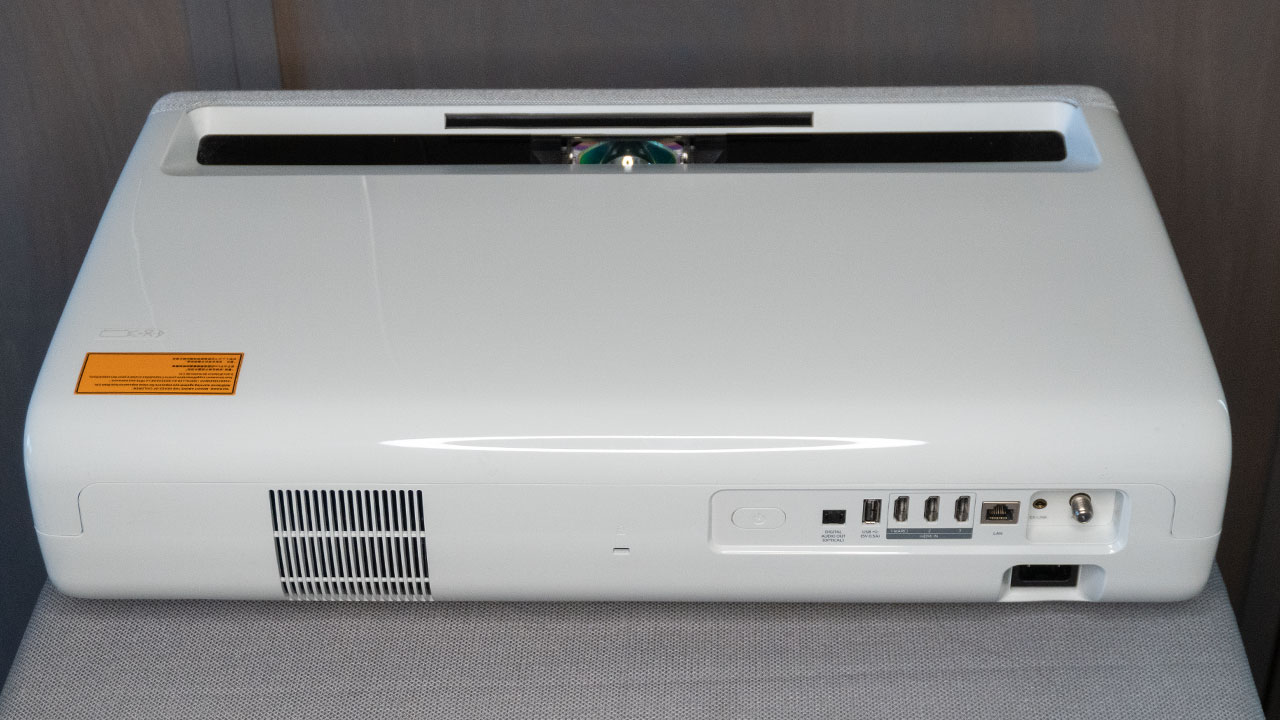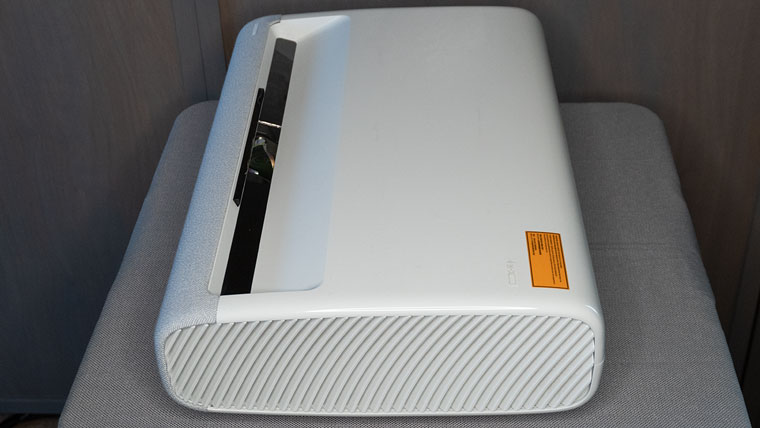Panasonic PT-AR100U - projector screen - cave / home theater
Dedicated Home Theaters (or close) Common attributes medium to (ideally) very dark surfaces, all window lighting under full control, basically full control of other lighting, but rooms with low amounts of amibient are in this group, be they home theaters or just darker rooms.
With the Epson in such a room, the next question becomes how big is the screen, and the third - how far back is the projector mounted (in terms of zoom range. Full telephoto, loses enough brightness to be taken into consideration.
OK, unless you have the projector mounted at or very near the telephoto aspect of the zoom, you've got about 600 lumens, and over 1600 in best and brightest. Most of you, without really large screens can run your 2D movies not only in Best, but in eco-mode on the lamp. I'm talking about 1.0 gain screens up to say 110" diagonal, and with a 1.3 gain screen roughly 125" diagonal (that's almost 16 foot lamberts), so with the gain, that's about 20 ft lamberts with a brand new lamp. That's respectable brightness, even at the end of the lamp - you'll still be down around 10! 12 ft lamberts is the lower end of the recommended brightness for movie theaters.
In Dynamic mode, you'll have tons of brightness, so, no worries, even with some lights on.
Unless you have placed intentional side lighting in your room (ie. sconces) or have blacked out windows that you want to open for non-movies, no need to go with anything but a white screen. Modest gain (ie. 1.3 or 1.4) is just fine and buys you a bit more screen size or image brightness. In other words, screens like the Stewart Studiotek 130 (1.3) and Carada Brilliant White (1.4) screens that are the screens I normally use.
If you do want to be able to reject some ambient light from those sides, then the better alternative are HC screens like the Stewart Firehawk, Da-lite HC Cinema Vision, and other similar screens. If you are going small screen (92" or less), you might choose a darker HC gray screen like the Grayhawk or HC-Da-Mat. The downside to those darker screens is for 3D, where brightness is relatively scarce.
Now, what happens when we go to a family room...
Panasonic PT-AR100U - projector screen - family room
Walls are lighter, or even light - off white. Ceilings and floors also brighter. Even for movie viewing, the reflected light of your image off the screen will bounce around and eventually, a noticeable amount will reflect back onto the screen. Contrast will diminish, but - an important but: Projectors with better black levels will still always look better than those without, until that point where either is significantly washed out. Such is life. There are some things you can do about that.
Let's take a break and consider the affects of room surfaces, and how that affects your decisions.
First Image below taken using 128" screen, an old (2007) Sony VW60. A projector that we measured at a max of under 700 lumens. This room at that time, was football during the day, everything else, at night only. (My other room was far darker.)
The second image - same setup, the old Epson 1080UB - several generation forerunner to the 5010, and twice as bright as the Sony. The 5010 is about tNow consider the Panasonic AR100U is roughly 3 times as bright in Dynamic mode. This is the Firehawk screen. It looked far better straight back, with most of that light from the doors knocked out.
My presumption is, you care about good movie performance, and having good blacks, since you are considering, or own this projector. Rooms with a fair amount of light are often just fine for almost all HDTV and definitely sports. They won't be significantly impacted by reflected light from the original image.
This image shows the difference after darkening ceiling, and taking the walls to a dark rust color: Even with the door shades partially open, the JVC used in this picture had about the same brightness as the Sony in the first image. The moral to the story - darker walls can easily offset having fewer lumens.
I loved having that Stewart Firehawk G3 (in the images above) in my last home for handling a light surfaced room. It was 128" diagonal in a room with a cathedral celing. When I started out there, all the walls were off white, as was ceiling, and carpet was gold. Lots of windows, which I covered with pleated shades - but with no channels. The Firehawk allowed me to have a good picture even with a moderate amount of light (can reada newspaper bright)
That HC gray screen rejects most of the side lighting. This allowed me to even have my slide window shades open a few inches on sunny days, and still have a large, great football image. If your ambient is coming from straight back near the projector, like rear windows, the HC gray won't help you.
Ultimately, though, an HC gray is going to be the best choice for most folks with lighter rooms, and especially if the lights are on the sides. Consider the especially the Firehawk G3, and the various Screen Innovations Black Diamond screens (different gains, etc.) which are especially good, but also relatively pricey. Also: Elite's HC Gray, Da-lite's HC-Da-Mat, and so on. Typically we're talking screens with gains of 0.8 to 1.1 gain. The Epson's inherently pretty bright on all but the largest screens, so trading a little brightness for some ambient light rejection is a plus. (Note HC screens are a touch darker in the corners/sides.)
Don't get me wrong, you can go with a standard white surface, but in a light surfaced room, you'll also appreciate the gray surface's ability to lower the overall black levels.
OK, what about 3D?
3D Screens: With active shutter glasses based 3D, almost any screen will work. I'm told there are some slight differences, but haven't heard of any real issues.
With 3D, the issue is brightness - therefore, make your decision, based on the above, for either room, consider:
With 1660 measured lumens in our "tuned" Dynamic mode, the picture's pretty good in 3D! Figure that the image to your eyes is about 1/4 as bright in 3D. That makes our 1660 in 3D, the rough equivalent of watching 2D at 415 lumens. Which is to say, about 2/3 the brightness of watching 2D in best mode.
Thus, the Epson's 3D brightest mode has the juice to handle most of those 110" and 110" screens with good brightness, and be a bit dim with those 125" and larger screens.
So, in figuring your screen size. you might, if you want to max out for 3D, 9 (depending on your type of room - cave or not), opt for, say, a 1.1 gain, instead of a .8 gain.
Or, you might want a 1.3 - 1.5 gain screen instead of a 1.0 - 1.1 gain. The Epson's 3D image is as bright as any 3D capable HT projector we've seen, including the Panasonic PT-AE7000, the less expensive Epson HC3010, the Acer...
I'm not a fan of the brighter high power screens like the Da-lite 2.5 gain, too narrow a viewing cone for my taste, but if you want really bright 3D, some of you might opt for the best 2D screen choice and get a pretty high gain screen - manual or motorized, to use only for 3D.
Hope that helps.




